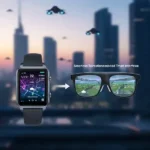Smart Glasses Privacy
Privacy concerns surrounding smart glasses are multifaceted, encompassing issues of unauthorized recording, data collection, facial recognition, and the overall erosion of personal privacy. Addressing these concerns requires a multi-pronged approach involving technological solutions, clear policies, legal frameworks, and user education.
Here are some key solutions for privacy concerns about smart glasses:
Technological Solutions & Design Principles:
- Prominent Recording Indicators: This is a fundamental solution. Smart glasses should have highly visible and unmistakable LED lights or other visual cues that are always active when recording video, taking photos, or livestreaming. These indicators should be difficult or impossible to cover or disable. The goal is to make it immediately obvious to bystanders when they are being recorded.
- Audible Cues: Similar to old camera phones, a distinctive, non-disableable shutter sound when a photo is taken or a consistent audio cue when recording starts/stops can further alert those in the vicinity.
- Privacy by Design: Manufacturers should build privacy into the core design of smart glasses from the outset. This includes:
- Ephemeral Data by Default: Images and videos taken should not be automatically uploaded to the cloud or stored indefinitely unless explicitly consented to by the user for a specific purpose.
- Smart Glasses Privacy Device Processing: Where possible, sensitive data processing (like basic object recognition) should happen on the device itself, minimizing the need to send data to the cloud.
- Limited Data Collection: Only essential data needed for the device’s functionality should be collected. Users should have granular control over what data is collected and how it’s used.
- Strong Encryption: All data, both stored on the device and transmitted to the cloud, should be robustly encrypted to prevent unauthorized access.
- User Controls and Transparency:
- Clear Privacy Settings: Easy-to-understand and accessible privacy settings that allow users to control data sharing, recording preferences, and AI features.
- Opt-in for Sensitive Features: Features like facial recognition or advanced AI analysis should be strictly opt-in, with clear explanations of their implications.
- Data Deletion Capabilities: Users should have the ability to easily review and delete any data (voice recordings, photos, videos) associated with their smart glasses.
- Facial Recognition Limitations/Bans: Given the highly sensitive nature of facial recognition, many advocate for:
- Technical limitations: Preventing smart glasses from integrating with or performing real-time facial recognition on individuals without their explicit consent.
- Regulatory bans: Implementing legal prohibitions on the use of facial recognition by smart glasses in public spaces.
- Secure Authentication: Implementing strong authentication mechanisms (e.g., two-factor authentication, biometric verification like iris scans) to prevent unauthorized access to the device and its data if lost or stolen.
Policy & Legal Frameworks for Smart Glasses Privacy:
- Clear Legislation and Regulations: Governments need to enact specific laws addressing smart glasses privacy and wearable technology, similar to GDPR in Europe. These laws should:
- Define what constitutes lawful recording in public and private spaces.
- Establish data retention policies for smart glass data.
- Assign clear responsibilities to manufacturers regarding data security and user privacy.
- Address the legality of facial recognition and other advanced AI features.
- Public Awareness Campaigns: Educating the public about the capabilities and privacy implications of smart glasses is crucial. This can help individuals make informed decisions about their own privacy and how to react when they encounter smart glass users.
- Industry Best Practices and Codes of Conduct: Tech companies should collaborate to establish industry-wide best practices and ethical guidelines for the design, development, and use of smart glasses. This could involve self-regulatory bodies that enforce these standards.
- Consent Mechanisms: Exploring innovative ways to obtain consent from bystanders for recording. While challenging in public, approaches like clear visual indicators and social norms can contribute.
Social Norms & User Responsibility:
- Promoting Responsible Use: Manufacturers and privacy advocates should actively promote responsible and ethical use of smart glasses. This includes guidelines like:
- Powering off in private spaces: Encouraging users to turn off recording features in sensitive environments like restrooms, changing rooms, or private conversations.
- Seeking consent: Encouraging users to ask for permission before recording individuals, especially in more intimate or private settings.
- Situational Awareness: Emphasizing that users should be mindful of their surroundings and the potential impact of their recording on others.
- “Glasshole” Prevention: The negative public reaction to early smart glasses (Google Glass) highlights the importance of social acceptance. Manufacturers need to design devices that are less intrusive and users need to be more considerate of others’ privacy.
- Public Discourse: Ongoing open discussions among technologists, ethicists, legal experts, and the public are essential to continually re-evaluate and adapt privacy solutions as the technology evolves.
While there’s no single “magic bullet” solution, a combination of robust technological safeguards, comprehensive legal frameworks, and a widespread commitment to responsible use and social awareness can significantly mitigate the smart glasses privacy concerns and pave the way for their more ethical and widely accepted adoption.
Additional helpful information
Here is a discussion about Smart Glasses technology – Smart Glasses Technology – Key Technologies in Smart Glasses
Learn about safety and health issues for smart glasses – Smart Glasses Safety and Health Issues to Know




